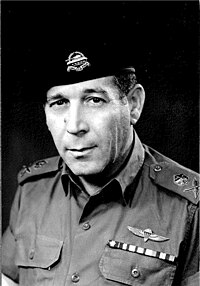Israel Tal
This article contains weasel words: vague phrasing that often accompanies biased or unverifiable information. |
Israel Tal | |
|---|---|
 | |
| Nickname(s) | Talik, Mr. Armour |
| Allegiance | Israel |
| Service/ | Israel Defense Forces |
| Years of service | 1948-1974 |
| Rank | Aluf (Major General) |
| Commands held | Bahad 1-IDF Officers School (1954-1956), 7th Armor Brigade (1959-1960), Commander of the Armor Forces (Gaysot Hashiryon), 84th Armored Division, Deputy Chief of the General Staff |
| Battles/wars | War of Independence, Sinai War, Six-Day War, Yom Kippur War |
| Awards | Israel Prize (1997) The Eliyahu Golomb Israel Security Award |
Israel Tal (Hebrew: ישראל טל) (born 1924), also known as Talik (Hebrew: טליק), is an Israel Defense Forces (IDF) general known for his knowledge of tank warfare. Tal was a brigade commander during the Sinai War, an armored-division commander in Sinai Peninsula during the Six Day War, and commander of the southern front during the final stages of the Yom Kipur War.
The Israeli government decided in 1970 that it needed tank-building capacity. General Israel Tal led a development team which took into consideration Israel's battlefield characteristics and lessons learned from previous wars, and began the development and building of Israel's Merkava tank.
Israel Tal's picture appears in Patton Museum of Cavalry and Armor "Wall of Greatest Armor Commanders" along with Moshe Peled (also Israeli), Americans George S. Patton and Creighton Abrams and German field-marshal Erwin Rommel.
Tal received the Israel Prize in 1997 for "[A] special contribution to the society and state". In 2002 he was chosen "Knight of Quality Government" by the Movement for Quality Government in Israel in the "Military and security" category.
Armour Doctrine
Gen. Tal is the creator of the Israeli armour doctrine which led to the Israeli successes in the Sinai in the Six Day War. After the Suez Crisis, Tal organized the armour into the leading element of the Israeli Defense Forces, characterized by high mobility and relentless assault. General Tal took over Israeli armor corps in 1964 and re-trained all Israeli gunners to hit targets beyond 1.5km. [1] In open terrain, this long distance gunnery proved vital to survival of Israeli armor corps for subsequent wars. Mobility is comparable to the German Blitzkrieg and many hold it to be an evolution of that tactic. Tal's transformation and success in 1967 led the IDF to expand the role of armour. This led to reduced attention to other less glamorous aspects of the army such as the Infantry. In the 1973 Yom Kippur War, excessive focus on fast striking armour left the IDF without adequate defensive ability. Only in latter stages of the war did the armour break out and show its potential when General Ariel Sharon's armour was able to penetrate the Egyptian lines, cross the Suez Canal and envelope the Egyptian 3rd Army near Suez.
While the IDF has become a more balanced force since 1973, Tal's influence on armour doctrine was very important to the IDF's development and has influenced armoured doctrines the world over.
References
- ^ George Forty -Tank Action pp 249-250, ISBN 0-7509-0479-8
